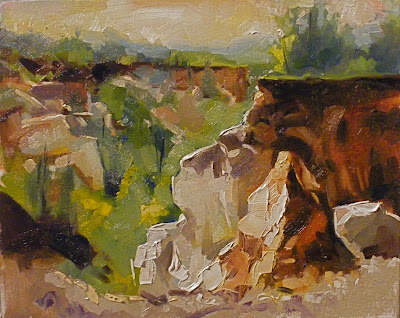Providence Canyon: Stewart County, GA, 7miles west of Lumpkin
The great irony of this park is that from a biological standpoint, it is a geologic and natural tragedy. For the artist it is a stunning reveal of what may lie hidden beneath our feet. Providence Canyon is breathtaking for both its colorful range of soils; umber, maroon, red oxide, orange, yellow ochre, white, lavender, and blue grays, and for its variety of land formations; plateaus, cliffs, chasms, and pinnacles.
Little did the farmers of the 1800's know that by leaving their fields fallow after harvesting, erosion would cause the sandy, clay soil to progressively form gullies, then ravines, and then eventually the canyons we see today. This ecological disaster, formed by rain water run-off, differs from other canyons which are usually formed by erosion from rivers. Located in the Coastal Plain, Providence Canyon is surrounded by a dry, deciduous forest which helps to curb the continual advance of erosion damage. Because the soil is so soft, those areas left unprotected by trees and understory are in a constant state of flux. A heavy rain can wash away pinnacles in a night, or cause further erosion of the canyon walls which can be as high as 150'.
The ancient history of this area is written through the examination of the soil. The top layer of the soil is a fine sand mixed with kaolin, a white clay. The middle layer is more colorful with cross-beds which are thinner layers of sand which run at an angle within the larger horizontal layers. Cross-beds are caused by strong currents of water which deposit the sand. They are stained yellow by limonite and purple by manganese. The next layer is a black and yellow mica rich clay. The canyon floor is orange and varies in composition from clay to bedded sand in masses.
THE ARTIST'S PERSPECTIVE, 2014.04.20
Although we painted the canyon in April, a better view is possible in the winter when the deciduous trees lose their leaves and offer a more impressive, unobstructed vista. I would also assume that painting at sunrise and sunset would show spectacular color, accenting the warm range of soil colors against the cooler greens of the foilage. In the fall there would be even more color offerings. The rare plumleaf azalea which only grows in this region should not be missed when it blooms in late summer.
This was an easy place to paint, with parking close to the rim, for those seeking nature but, not wanting an arduous hike. There are trails to the bottom of the canyon but, I am not sure if painting there would prove problematic; craning one's head upward and painting a cliff wall at close range.
Providence Canyon stands as a testament to man's destructive influence on the environment. However, it is interesting to note that this permanent altering of the environment occurred even with native Americans. Mountain tops and ridges were deforested for planting crops, destroying the habitat of old growth forests. Fishing weirs of stone were constructed in rivers, and some still survive today. Mounds, like those of Kolmoki, were constructed from surrounding soils. In areas of high flood risk, where somewhat domesticated animals grazed, an area of higher land was amassed to keep them safe and contained during a flood. So it continues but, the march towards destruction advances at a more aggressive pace now, giving us greater cause to cherish the natural spaces that still remain. That is why I paint and write this blog.
We had great weather and the wind, as it rose from the canyon, was cooling. I was glad I used my umbrella for protection from the sun. Kendall Portis, Mayte Parsons, Myrtha Vega, and myself, Nancy Hunter, made the 2 1/2 hour drive down. It took at least an hour to scout for a good location to paint as most of us had not been there in a while. Such a beautiful panorama left us all wanting more time to paint this complex setting.
 |
| Nancy Hunter, 'Providence Canyon', Oil/Canvas, 8 x 16" |
 |
| Kendall Portis, 'View from Above', Oil/Canvas, 8 x 10" |
 |
| Mayte Parsons, 'Providence Canyon I', Oil/Canvas, 10 x 10" |
 |
| Mayte Parsons, 'Providence Canyon II', Oil/Canvas, 10 x 10" |
 |
| Myrtha Vega, 'Providence Canyon Rim View I', Pen & Ink/Paper, 9 x 12" |
No comments:
Post a Comment